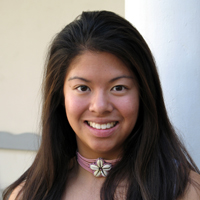 How many five-foot tall college basketball players do you know?
How many five-foot tall college basketball players do you know?
“Five one and three-quarters,” Kari Oki ’09 corrects.
Playing basketball for the CMS (Claremont McKenna-Scripps-Harvey Mudd) team earned Kari more than her share of curious looks, but it also pointed her toward a self-designed major in motion science and a career path that has led her into the country’s premier doctoral program in physical therapy.
“I used to get hurt a lot playing basketball in high school [at Iolani School in Honolulu, Hawaii],” Kari explains, “and I went to lot of physical therapy clinics. I was always interested in movement and how bodies work, and I wanted to be able to help people.”
At the end of her freshman year, Kari approached John Milton, Professor of Computational Neuroscience in the Joint Science Department (JSD). While the JSD is the “home” science department for students at Scripps, Claremont McKenna, and Pitzer Colleges, the interdisciplinary, five-college neuroscience major also offers students course options at several of the Claremont Colleges. Milton points out that, with 77 million aging Americans and a growing number of war veterans with brain injuries, the field of neuroscience is a true growth industry.
When Professor Milton taught Kari in a neurobiology course, he learned just how dangerous a student she could be. “If you talk to Kari, you’d never know how brilliant she is. She’s very friendly and happy. But then she starts asking questions.
“I couldn’t make an exam that was tough enough for her. She would get a perfect score, and meanwhile the rest of the class was gasping. We have lots of bright students but not as many with such deep commitment.”
To really challenge Kari, Professor Milton advised her to study abroad at the University of Queensland, in Brisbane, Australia for the best exercise/physiology training in any English-speaking country. In addition to the unique (for an undergraduate) experience of dissecting several cadavers, Kari was exposed to aboriginal approaches to knowledge and loved her experience in Australia. She came back to Scripps, eager to launch into her thesis research. All Scripps students complete a senior thesis, but, for students with science majors, thesis requires reading, writing, and plenty of hours in the lab.
Before focusing on a thesis topic, though, Scripps students in the JSD do plenty of hands-on lab-work and, as Professor Milton points out, essentially function as graduate students. With experience as research assistants to faculty, they can then effectively compete for spots in top graduate schools. Kari’s research on the role of sensory receptors in balancing tasks has a vital real-world application for the aged or those with brain injuries who are vulnerable to falls.
In 2009 Kari graduated with a degree in Motion Science, reflecting the range of studies and research she’d completed in anatomy, biology, chemistry, neuroscience, physics, and physiology.
“I helped her design her major,” says Professor Milton, “and I made sure to make it very rigorous to avoid any suspicion that it wasn’t ‘legit.’ I wanted to prepare her for the difficult exams she’ll face in her DPT [Doctor of Physical Therapy] program. The fact that the number one DPT program in the country, at USC, and the program at UCSF were competing to get her shows how highly they thought of her.”
How did Kari become such a hot recruit after attending a liberal arts college? The opportunity to perform research, study abroad at a top program in her field, and her close relationships with faculty didn’t hurt. College was about more than academics for Kari, though. Besides her involvement on the basketball team, Kari was president of a breast cancer awareness club, and was active in the Hawaii Club and an Asian American mentor program. But Kari thinks her Scripps education prepared her for her career in other ways as well.
“I love having the liberal arts background now that I’m at USC. Through the Core Curriculum and breadth requirements, Scripps taught me that we can’t objectively know everything, that we have to know how to approach issues through different modes of thought and how to respect everyone’s opinions. Devising the best treatment in physical therapy requires a collaborative process, so I feel really prepared.”

